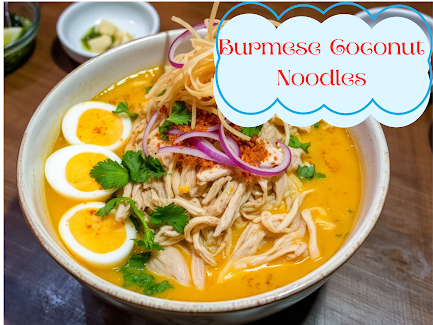Burmese Coconut NoodlesBurmese Coconut Noodles, or Ohn No Khao Swe, is a traditional Burmese noodle soup made with creamy coconut milk, spiced chicken broth, and wheat or rice noodles, topped with a variety of garnishes like boiled eggs, crispy noodles, lime, and chili oil. It’s a comforting, mildly spiced, and aromatic dish that’s rich, hearty, and deeply satisfying, commonly served as a main meal in Myanmar.
2. Etymology
-
Ohn = Coconut
-
No = Oil or cream (contextually refers to coconut milk)
-
Khao Swe = Noodles
So, the name directly translates to “Coconut Noodles.”
3. Key Ingredients
Base Soup:
-
Chicken (usually thigh or breast, shredded)
-
Coconut milk
-
Onions and garlic
-
Ginger
-
Chickpea flour or besan (for thickening)
-
Fish sauce or soy sauce
-
Turmeric and mild curry spices
-
Chicken broth or water
Noodles:
-
Egg noodles (traditionally), or rice noodles
Common Toppings:
-
Hard-boiled eggs (halved)
-
Fried crispy noodles
-
Chopped red onion
-
Fresh cilantro
-
Lime wedges
-
Chili oil or chili flakes
-
Fried garlic or shallots
4. Flavor Profile
-
Creamy and mild from the coconut milk
-
Savory and umami-rich from chicken, fish sauce, and chickpea flour
-
Aromatic with turmeric, ginger, and garlic
-
Slightly tangy when served with lime
-
Texturally dynamic with both soft noodles and crispy toppings
5. Preparation Overview
-
Sauté aromatics (onion, garlic, ginger, turmeric) in oil.
-
Add chicken and cook until tender.
-
Mix in chickpea flour to thicken the broth.
-
Add coconut milk and simmer until creamy and flavorful.
-
Boil noodles separately and place in serving bowls.
-
Ladle the hot coconut chicken curry over the noodles.
-
Top with garnishes like boiled eggs, crispy noodles, lime, and chili oil.
6. Cultural Significance
-
Considered comfort food in Myanmar, often served at family meals or gatherings.
-
Has roots in Burmese cuisine, but shows influences from neighboring Thailand and India.
-
A close cousin to Thai Khao Soi, but usually milder and thicker in texture.
-
Commonly eaten for lunch or dinner, and beloved across generations.
7. Variations
-
Vegetarian Version: Made with tofu and vegetable broth.
-
Beef or Seafood Options: Swapping out the chicken.
-
Gluten-Free: Use rice noodles and tamari instead of soy sauce.
-
Spicy Version: Boosted with chili paste or extra cayenne.
-
Street-Style: Topped with extra crispy noodles and more fried garlic.
8. Serving Suggestions
-
Serve hot in large bowls.
-
Accompany with side condiments: lime wedges, chili oil, extra fried onions.
-
Often enjoyed with sweet Burmese tea or simple side salads.
9. Nutritional Info (Approximate per serving)
-
Calories: 400–600 (varies by portion and toppings)
-
Protein: 20–30g
-
Fats: 20–30g (from coconut milk and toppings)
-
Carbohydrates: 40–60g
10. Why People Love It
-
One-pot meal that’s rich, filling, and full of flavor
-
Combines soft, creamy, and crunchy textures in one bowl
-
Family-friendly, not too spicy
-
A great way to explore Burmese cuisine
-
Highly customizable based on dietary needs
Would you like a recipe card, infographic, or image generation prompt for this dish as well?

Comments
Post a Comment